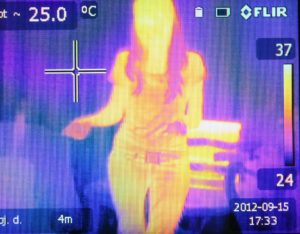Thermographic inspections have been used in over 30 years. In the hands of a trained and experienced operators, it can provide a wealth of information that will increase productivity and safety. There has never been a better time to capitalize on the benefits of an infrared inspection program.

In this article, we will explore some of the more common applications of commercial and industrial thermography. What is thermography? Infrared thermography is the use of an infrared imaging system to detect, display and record thermal patterns and temperature values across a given surface. All objects above 0 degrees Kelvin, produce infrared radiation. While it is invisible to the human eye, it is detectable to these special cameras. Infrared data can be observed in real time or captured to video tape PC card or electronic media for post analysis. Today’s thermal images are devices that can fit in your hand. These convert the invisible energy in a monochrome image which represents the apparent thermal patterns across the surface of the object being inspected. When recorded on photographic film, these are referred to as hectograms. Many modern thermal images are capable of recording temperature as well. Once captured, thermal images and associated temperatures can be restored for future reference and analysis.
Infrared technology is non destructive. They don’t interrupt service and additionally they don’t emit any harmful radiation and are completely passive.
So why thermograhpy?
As we move forward into the 21st century, companies will continue facing demands associated with the global economy. These include increased competition both domestically and abroad. As the world becomes smaller, the number of competitors expand. No more will we be the best in the world. In a global economy, companies must provide the most efficient product while remaining profitable. Often times this is associated with a process of performing more maintenance tasks with fewer personnel. Many companies are utilizing maintenance technologies to reach their objectives. While infrared thermography is the newest non destructive technology, it can help revive substantial improvements in performance and cost savings. Other proving technologies include vibration analysis and ultra sound (to name a few.)
Uses of thermography: There are many uses. These include preventive maintenance predictive maintenance, condition monitoring, forensic investigations, research and development and quality assurance. Thermograhpy may be applied to any situation where knowledge of thermal patterns can provide meaningful data of a structure object or system. Thermography is a growing field where new applications are constantly being developed.
Common industrial applications: Thermography can be applied to a range of systems, objects and structures. Common industrial applications include: electrical distribution systems to locate loose connections, overloads, imbalanced loads, open circuits, defective equipment.
I know this article should have probably been the first one published, however better late than never right? I just remembered that many of you aren’t going to understand the importance of thermography. So as I’ve said before, the purpose will be to educate you as much as possible on the importance of this technology.
More to be discussed in the future.
In the video below, you will basically see some similar things being mentioned in terms of the uses of this technology and its applications. So hope you enjoy it and find it informative!